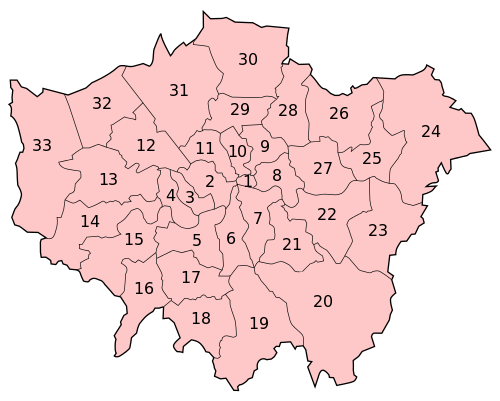London
![]()
The title of this article is ambiguous. For other meanings, see London (disambiguation).
London (German pronunciation [ˈlɔndɔn], English pronunciation [ˈlʌndən]) is the capital of the United Kingdom and the country part of England. The city is located on the River Thames in southeast England on the island of Great Britain. The current administrative area, with a total of 33 boroughs, was formed in 1965 with the creation of Greater London. There lived in 2019 about 8.96 million people, of which about 3.3 million in the 13 boroughs of Inner London.
Founded by the Romans in 50 AD as the settlement of "Londinium", the city became the capital of the Kingdom of England after the Norman Conquest in 1066 and subsequently became the seat of the British Royal Family. Already in the Middle Ages, London became an important trading centre in Europe. Under the reign of Elisabeth I. in the 16th century, its importance as a harbour city of the North Sea increased. Due to the beginning of the industrialisation in the 18th century, the population of London also increased, so that the city was one of the first to exceed the limit of one million inhabitants in the year 1800. Up to the year 1900, the population increased sixfold and in the 19th century, London not only became the capital of the British Empire but also the biggest city of the world that it remained until 1925. It developed into an important city of technology and industry as well as politics, which makes it one of the world cities until today.
London is one of the most important cultural and commercial centres in the world with numerous universities, colleges, theatres and museums. The city is also one of the largest financial centers in the world, along with New York, Singapore and Hong Kong. Historic buildings such as the Palace of Westminster and the Tower of London are among the UNESCO World Heritage Sites. With over 19 million tourists from abroad every year, London was the most visited city in the world after Bangkok in 2016.
Geography
Geographical position
The geographical coordinates of the city centre near Trafalgar Square are 51° 30′ north latitude and 0° 8′ west longitude. The location near the prime meridian is no coincidence, because this was laid by the royal observatory, the Royal Greenwich Observatory in Greenwich; it is the starting point of the longitudes and thus the time zones.
London stretches about 44.3 kilometres along the navigable River Thames and lies an average of 15 metres above sea level. London grew out of a settlement on the north bank, now the City of London. London Bridge was the only bridge over the river until 1739.
For this reason, the greater part of the city is located north of the river. With the building of more bridges in the 18th century and the construction of railroads in the 19th century, the city began to expand in all directions. The landscape is flat to slightly undulating, which encouraged unhindered growth.
The Thames was much wider and shallower in earlier times than it is today. Today it is almost entirely confined by embankments and most of the 15 or so tributaries flow underground. The tides of the North Sea are still clearly noticeable in London, the city is therefore vulnerable to flooding and storm surges. At Woolwich - located east of Greenwich - the Thames Barrier was built in the 1970s to contain this danger.
Geology
South-east England with the capital London, the climatically most favoured part of Great Britain, differs in many respects from the other parts of the island. The geological structure is determined by the Mesozoic sediments, which gave rise to a generously structured stratified landscape. Its heights nowhere rise high, so that the whole area enjoys the climatic advantages of the south-east. Historically, London benefited from its location in the middle of an arable region. The south-east, close to the continent, has always been considered as the heavyweight of the island empire. It was here that the conquerors coming from the mainland - Romans, Saxons, Normans - first gained a foothold. Even when with the discovery of America and the development of the overseas shipping the outer sides of the island were more animated due to their more favourable position, the old cultural centre could assert itself. London remained the gateway to the island.
City breakdown
London is divided into 32 boroughs (London Boroughs) and the City of London.
|
|
|
Climate
London is in the temperate climate zone. Summers are warm, but rarely hot; winters are cool, but the temperature rarely drops below freezing. The warmest month is July, with an average of 16.3 degrees Celsius; the coldest is January, with an average of 3.9 degrees Celsius. The highest temperature ever recorded in London was 37.9 degrees Celsius, measured during the 2003 heatwave. The large built-up area retains heat, creating a microclimate. Sometimes it is up to five degrees warmer in the city than in the surrounding countryside.
The average annual temperature is 9.7 degrees Celsius and the average annual rainfall is 611 millimeters. In the months of October, November and December there is the most precipitation with an average of 57 millimeters and the least in February with 36 millimeters on average. Snow falls rather rarely, at most a few centimetres per year. Events like the snow disaster of 1978 are a rarity. At the beginning of February 2009, there was the worst snow chaos in 18 years, when over 15 centimetres of fresh snow fell. Inversions, on the other hand, are not uncommon. One of these led to a major smog disaster in 1952.
Model calculations from 2019 on the consequences of man-made climate change show that London would already be shifted into a different climate zone if the RCP4.5 scenario, which is estimated as optimistic, were to occur; according to this, the climate in London would already be more similar to the previous climate in Barcelona, which is located significantly further south, in 2050.
| London | ||||||||||||||||||||||||||||||||||||||||||||||||
| Climate diagram | ||||||||||||||||||||||||||||||||||||||||||||||||
| ||||||||||||||||||||||||||||||||||||||||||||||||
| Monthly average temperatures and precipitation for London
Source: | ||||||||||||||||||||||||||||||||||||||||||||||||||||||||||||||||||||||||||||||||||||||||||||||||||||||||||||||||||||||||||||||||||||||||||||||||||||||||||||||||||||||||||||||||||||||||||||||||||||||||||||||||||||||||||||||||||||||||||||||||||||||||||||
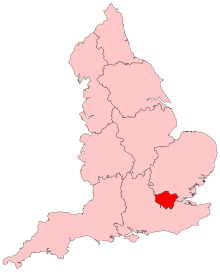
Location of London in England
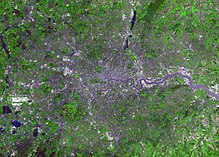
London as seen from the Terra satellite
History
→ Main article: History of London
Ancient
The existence of a pre-Roman settlement of the Celts in the area of the City of London could not be proven. Probably in 47 AD the Romans founded the city of Londinium. In 60 or 61 AD the Icenians, led by Queen Boudicca, destroyed the settlement. Londinium was rebuilt and replaced Camulodunum (Colchester) as the capital of Britain in the early 2nd century. From 197 AD Londinium was the capital of the province Britannia superior, and from about 300 AD of the province Maxima Caesariensis. Wall fortifications were built around the city.
In 410 AD the Romans withdrew their legions and the population was increasingly defenceless against raids by Germanic tribes. After the conquest of England by the Angles and Saxons, Londinium deteriorated into an uninhabited collection of ruins by the end of the 5th century.
Medieval
The Anglo-Saxons initially avoided the immediate vicinity of the destroyed town. In the later 7th century they founded the settlement of Lundenwic to the west of it, which belonged first to the kingdom of Mercia and later to the kingdom of Essex. Under the leadership of Alfred the Great, King of Wessex, the Anglo-Saxons recaptured the area at the mouth of the Thames from the Danes in 878. In the following years, the area was re-settled within the Roman city walls. The newly formed town was called Lundenburgh.
In 1066 the Normans conquered England and London replaced Winchester as the capital. The new ruler William I confirmed the special rights of London. Richard the Lionheart appointed the first Lord Mayor (mayor) in 1189, who was then elected by the increasingly powerful merchant guilds themselves from 1215. In 1209, the first bridge built of stone, the London Bridge, was completed, which was the only bridge in the city centre today until 1750. Several times London had to endure plundering by rebellious peasant armies, for example in 1381 during the Peasants' Revolt and in 1450 during the Jack Cade Rebellion.
In the War of the Roses, which ended in 1485 with the coronation of Henry Tudor as Henry VII, the city held to the Yorks' party. The Reformation broke the power of the church, which until then held about half the land; the redistribution of ecclesiastical estates from 1535 ushered in an era of economic growth and London rose to become a leading trading city.
early modern period
London had to endure some setbacks in its eventful history. After the establishment of the first large trading companies and the Royal Exchange had driven the economic rise in the 16th century, the city was hit by the "Great Plague" in 1664 and 1665, which claimed over 70,000 lives. In September 1666, the "Great Fire of London" devastated large parts of the city. About 13,000 houses and 89 churches fell victim to the flames.
The city was rebuilt after the devastating fire. Plans for a fundamental redesign failed, however, because the costs were too high, so the new houses were essentially built along the old winding streets. The architect Christopher Wren was responsible for the rebuilding. As a result, almost all the aristocratic residents left the old city centre for good and had new representative houses built in the up-and-coming West End. The poorest sections of the population, who had to make a living in the expanding port, were forced into the East End. At the end of the 17th century, London rose to become the most important financial centre in the world.
During the 18th century, London grew beyond its historic boundaries. New bridges across the Thames allowed the city to expand southward. In June 1780, London was the scene of the Gordon Riots, when fanatical Protestants opposed equal rights for Catholics.
Modern
In the course of the 19th century, the population multiplied, the construction of numerous suburban railways and subways allowed a rapid expansion of the built-over area. London gained great importance as the capital of the British Empire during the Victorian era. In 1851, according to the census, London was the largest city in Europe with a population of 2,651,939 and the center of the industrialized world. The first World's Fair, the "Great Exhibition", took place here in the same year.
The sprawling metropolitan area was fragmented into numerous parishes and judicial districts. The Metropolitan Police was founded in 1829 as the first special-purpose association, which subsequently took over the fight against crime throughout the metropolis, which had previously been carried out on a private basis. In 1855, unification in the field of building followed with the Metropolitan Board of Works. The London sewerage system, constructed under the direction of Joseph Bazalgette, is considered the largest building project of the entire 19th century. In 1889, with the County of London, a uniform administrative region was created for the entire conurbation for the first time ever.
The first half of the 20th century was marked by the expansion of the built-up area on a scale never before seen. The new suburbs were almost entirely outside the County of London: throughout Middlesex, west of Essex, north of Surrey, north-west of Kent and south of Hertfordshire.
During the Second World War, especially in 1940/41, London suffered severe destruction, particularly in the eastern industrial areas, due to attacks by the German Luftwaffe. These bombings went down in the history of the city with the name "The Blitz". A second wave of attacks followed in 1944/45 as part of Unternehmen Steinbock and with the V1 and V2 rockets. Almost 30,000 inhabitants died, hundreds of thousands were left homeless.
After the end of the war, the population dropped considerably as many Londoners settled in new satellite towns. In 1965, the Greater London administrative region was created, including the suburbs that had been created in the 20th century. Meanwhile, London lost its role as a major port, the facilities in the Docklands crumbled.
In 1981, an extensive urban development programme began, tens of thousands of service industry jobs were relocated from the City of London to the Isle of Dogs or newly created. A sprawling high-rise complex was built in Canary Wharf. The population rose again from its low point in the 1980s. In the years that followed, London consolidated its position as one of the world's most important cities for the global financial industry.
Several dozen people were killed in Islamist terrorist attacks on 7 July 2005. As a result, urban security measures were expanded. In 2011, the population rose to over 8 million, reaching a new high. In 2012, the Olympic Games were held in London.
In 2020, London was the city with the third most surveillance cameras per capita in the world.

Map of ancient Londinium
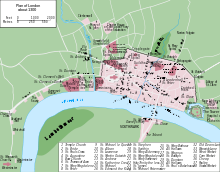
By 1300 London was still within the Roman city walls
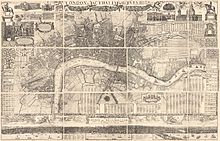
Map of London 1682
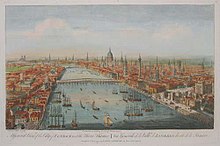
View of London 1751
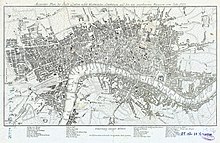
City map of London from the year 1770
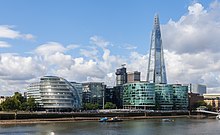
The Cityhall and the Shard
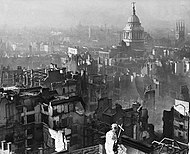
View from St Paul's Cathedral, after the Blitz bombing in the Second World War.
Questions and Answers
Q: What is London?
A: London is the capital of England and the United Kingdom. It is a major political, economic, and cultural centre with approximately 9.1 million inhabitants (2018).
Q: How long has London been around?
A: London has been around since it was founded by the Romans two millennia ago as Londinium.
Q: What is the City of London?
A: The City of London is England's smallest city, located in the original city centre of London. In 2011 it had 7,375 inhabitants on an area of 2.9 km².
Q: How many people live in the metropolitan area of London?
A: Approximately 15 million people live in the metropolitan area of London (London Metropolitan Area).
Q: What are some features that make up Greater London?
A: Greater London consists of a region surrounding the City of London which includes a Mayor and a London Assembly to lead it.
Q: What type of climate does London have? A: The climate in London is moderate.
Search within the encyclopedia
